Thanh Huy Nguyen
Towards Digital Twin in Flood Forecasting with Data Assimilation Satellite Earth Observations -- A Proof-of-Concept in the Alzette Catchment
May 13, 2025Abstract:Floods pose significant risks to human lives, infrastructure, and the environment. Timely and accurate flood forecasting plays a pivotal role in mitigating these risks. This study presents a proof-of-concept for a Digital Twin framework aimed at improving flood forecasting in the Alzette Catchment, Luxembourg. The approach integrates satellite-based Earth observations, specifically Sentinel-1 flood probability maps, into a particle filter-based data assimilation (DA) process to enhance flood predictions. By combining the GloFAS global flood monitoring and GloFAS streamflow forecasts products with DA using a high-resolution LISFLOOD-FP hydrodynamic model, the Digital Twin can provide daily flood forecasts for up to 30 days with reduced prediction uncertainties. Using the 2021 flood event as a case study, we evaluate the performance of the Digital Twin in assimilating EO data to refine hydraulic model simulations and issue accurate forecasts. While some limitations, such as uncertainties in GloFAS discharge forecasts, remain large, the approach successfully improves forecast accuracy compared to open-loop simulations. Future developments will focus on constructing more adaptively the hazard catalog, and reducing inherent uncertainties related to GloFAS streamflow forecasts and Sentinel-1 flood maps, to further enhance predictive capability. The framework demonstrates potential for advancing real-time flood forecasting and strengthening flood resilience.
Assimilation of SWOT Altimetry Data for Riverine Flood Reanalysis: From Synthetic to Real Data
Apr 30, 2025Abstract:Floods are one of the most common and devastating natural disasters worldwide. The contribution of remote sensing is important for reducing the impact of flooding both during the event itself and for improving hydrodynamic models by reducing their associated uncertainties. This article presents the innovative capabilities of the Surface Water and Ocean Topography (SWOT) mission, especially its river node products, to enhance the accuracy of riverine flood reanalysis, performed on a 50-km stretch of the Garonne River. The experiments incorporate various data assimilation strategies, based on the ensemble Kalman filter (EnKF), which allows for sequential updates of model parameters based on available observations. The experimental results show that while SWOT data alone offers some improvements, combining it with in-situ water level measurements provides the most accurate representation of flood dynamics, both at gauge stations and along the river. The study also investigates the impact of different SWOT revisit frequencies on the models performance, revealing that assimilating more frequent SWOT observations leads to more reliable flood reanalyses. In the real event, it was demonstrated that the assimilation of SWOT and in-situ data accurately reproduces the water level dynamics, offering promising prospects for future flood monitoring systems. Overall, this study emphasizes the complementary strengths of Earth Observation data in improving the representation of the flood dynamics in the riverbed and the floodplains.
Remote Sensing Data Assimilation with a Chained Hydrologic-hydraulic Model for Flood Forecasting
May 01, 2024Abstract:A chained hydrologic-hydraulic model is implemented using predicted runoff from a large-scale hydrologic model (namely ISBA-CTRIP) as inputs to local hydrodynamic models (TELEMAC-2D) to issue forecasts of water level and flood extent. The uncertainties in the hydrological forcing and in friction parameters are reduced by an Ensemble Kalman Filter that jointly assimilates in-situ water levels and flood extent maps derived from remote sensing observations. The data assimilation framework is cycled in a real-time forecasting configuration. A cycle consists of a reanalysis and a forecast phase. Over the analysis, observations up to the present are assimilated. An ensemble is then initialized from the last analyzed states and issued forecasts for next 36 hr. Three strategies of forcing data for this forecast are investigated: (i) using CTRIP runoff for reanalysis and forecast, (ii) using observed discharge for analysis, then CTRIP runoff for forecast and (iii) using observed discharge for reanalysis and keep a persistent discharge value for forecast. It was shown that the data assimilation strategy provides a reliable reanalysis in hindcast mode. The combination of observed discharge and CTRIP runoff provides the most accurate results. For all strategies, the quality of the forecast decreases as the lead time increases. When the errors in CTRIP forcing are non-stationary, the forecast capability may be reduced. This work demonstrates that the forcing provided by a hydrologic model, while imperfect, can be efficiently used as input to a hydraulic model to issue reanalysis and forecasts, thanks to the assimilation of in-situ and remote sensing observations.
Early Flood Warning Using Satellite-Derived Convective System and Precipitation Data -- A Retrospective Case Study of Central Vietnam
Mar 21, 2024Abstract:This paper addresses the challenges of an early flood warning caused by complex convective systems (CSs), by using Low-Earth Orbit and Geostationary satellite data. We focus on a sequence of extreme events that took place in central Vietnam during October 2020, with a specific emphasis on the events leading up to the floods, i.e., those occurring before October 10th, 2020. In this critical phase, several hydrometeorological indicators could be identified thanks to an increasingly advanced and dense observation network composed of Earth Observation satellites, in particular those enabling the characterization and monitoring of a CS, in terms of low-temperature clouds and heavy rainfall. Himawari-8 images, both individually and in time-series, allow identifying and tracking convective clouds. This is complemented by the observation of heavy/violent rainfall through GPM IMERG data, as well as the detection of strong winds using radiometers and scatterometers. Collectively, these datasets, along with the estimated intensity and duration of the event from each source, form a comprehensive dataset detailing the intricate behaviors of CSs. All of these factors are significant contributors to the magnitude of flooding and the short-term dynamics anticipated in the studied region.
Assimilation of SWOT Altimetry and Sentinel-1 Flood Extent Observations for Flood Reanalysis -- A Proof-of-Concept
Mar 21, 2024Abstract:In spite of astonishing advances and developments in remote sensing technologies, meeting the spatio-temporal requirements for flood hydrodynamic modeling remains a great challenge for Earth Observation. The assimilation of multi-source remote sensing data in 2D hydrodynamic models participates to overcome such a challenge. The recently launched Surface Water and Ocean Topography (SWOT) wide-swath altimetry satellite provides a global coverage of water surface elevation at a high resolution. SWOT provides complementary observation to radar and optical images, increasing the opportunity to observe and monitor flood events. This research work focuses on the assimilation of 2D flood extent maps derived from Sentinel-1 C-SAR imagery data, and water surface elevation from SWOT as well as in-situ water level measurements. An Ensemble Kalman Filter (EnKF) with a joint state-parameter analysis is implemented on top of a 2D hydrodynamic TELEMAC-2D model to account for errors in roughness, input forcing and water depth in floodplain subdomains. The proposed strategy is carried out in an Observing System Simulation Experiment based on the 2021 flood event over the Garonne Marmandaise catchment. This work makes the most of the large volume of heterogeneous data from space for flood prediction in hindcast mode paves the way for nowcasting.
Reducing Uncertainties of a Chained Hydrologic-hydraulic Model to Improve Flood Forecasting Using Multi-source Earth Observation Data
Jun 14, 2023Abstract:The challenges in operational flood forecasting lie in producing reliable forecasts given constrained computational resources and within processing times that are compatible with near-real-time forecasting. Flood hydrodynamic models exploit observed data from gauge networks, e.g. water surface elevation (WSE) and/or discharge that describe the forcing time-series at the upstream and lateral boundary conditions of the model. A chained hydrologic-hydraulic model is thus interesting to allow extended lead time forecasts and overcome the limits of forecast when using only observed gauge measurements. This research work focuses on comprehensively reducing the uncertainties in the model parameters, hydraulic state and especially the forcing data in order to improve the overall flood reanalysis and forecast performance. It aims at assimilating two main complementary EO data sources, namely in-situ WSE and SAR-derived flood extent observations.
Dealing With Non-Gaussianity of SAR-derived Wet Surface Ratio for Flood Extent Representation Improvement
Jun 14, 2023Abstract:Owing to advances in data assimilation, notably Ensemble Kalman Filter (EnKF), flood simulation and forecast capabilities have greatly improved in recent years. The motivation of the research work is to reduce comprehensively the uncertainties in the model parameters, forcing and hydraulic state, and consequently improve the overall flood reanalysis and forecast capability, especially in the floodplain. It aims at assimilating SAR-derived (typically from Sentinel-1 mission) flood extent observations, expressed in terms of wet surface ratio. The non-Gaussianity of the observation errors associated with the SAR flood observations violates a major hypothesis regarding the EnKF and jeopardizes the optimality of the filter analysis. Therefore, a special treatment of such non-Gaussianity with a Gaussian anamorphosis process is thus proposed. This strategy was validated and applied over the Garonne Marmandaise catchment (Southwest of France) represented with the TELEMAC-2D hydrodynamic model, focusing on a major flood event that occurred in December 2019. The assimilation of the SAR-derived wet surface ratio observations, in complement to the in-situ water surface elevations, is illustrated to consequentially improve the flood representation.
Gaussian Anamorphosis for Ensemble Kalman Filter Analysis of SAR-Derived Wet Surface Ratio Observations
Apr 03, 2023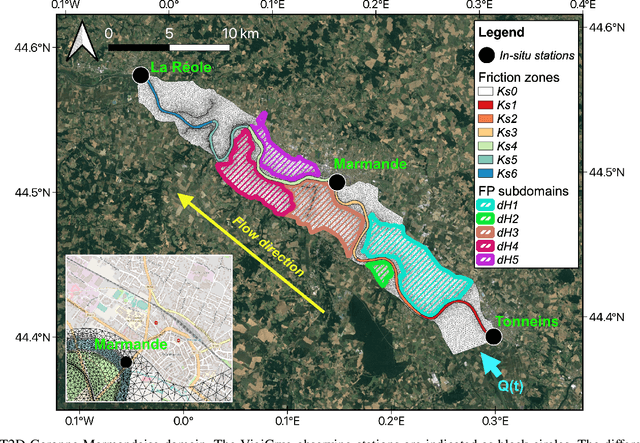
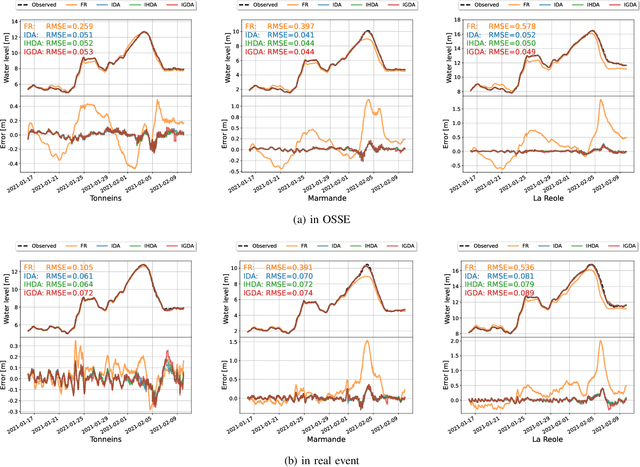
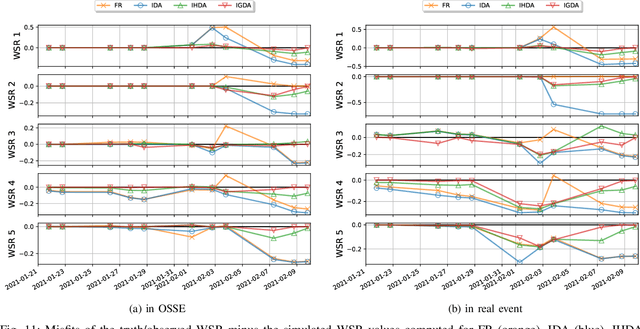
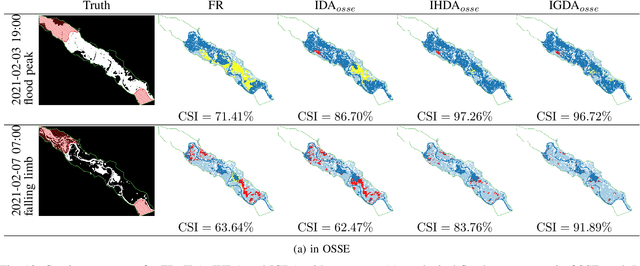
Abstract:Flood simulation and forecast capability have been greatly improved thanks to advances in data assimilation (DA) strategies incorporating various types of observations; many are derived from spatial Earth Observation. This paper focuses on the assimilation of 2D flood observations derived from Synthetic Aperture Radar (SAR) images acquired during a flood event with a dual state-parameter Ensemble Kalman Filter (EnKF). Binary wet/dry maps are here expressed in terms of wet surface ratios (WSR) over a number of subdomains of the floodplain. This ratio is further assimilated jointly with in-situ water-level observations to improve the flow dynamics within the floodplain. However, the non-Gaussianity of the observation errors associated with SAR-derived measurements break a major hypothesis for the application of the EnKF, thus jeopardizing the optimality of the filter analysis. The novelty of this paper lies in the treatment of the non-Gaussianity of the SAR-derived WSR observations with a Gaussian anamorphosis process (GA). This DA strategy was validated and applied over the Garonne Marmandaise catchment (South-west of France) represented with the TELEMAC-2D hydrodynamic model, first in a twin experiment and then for a major flood event that occurred in January-February 2021. It was shown that assimilating SAR-derived WSR observations, in complement to the in-situ water-level observations significantly improves the representation of the flood dynamics. Also, the GA transformation brings further improvement to the DA analysis, while not being a critical component in the DA strategy. This study heralds a reliable solution for flood forecasting over poorly gauged catchments thanks to available remote-sensing datasets.
Enhancing Flood Forecasting with Dual State-Parameter Estimation and Ensemble-based SAR Data Assimilation
Nov 14, 2022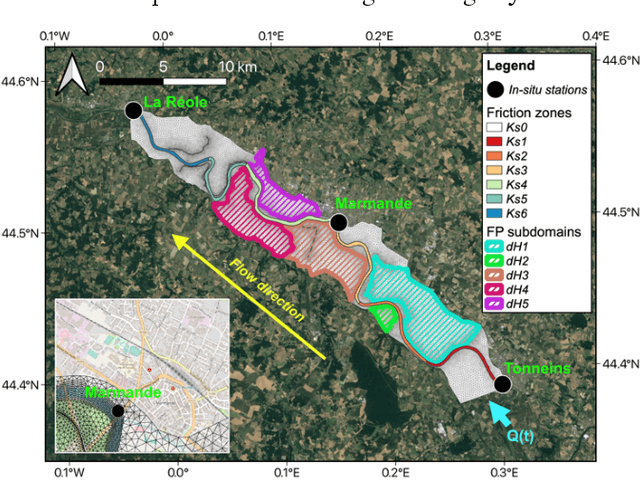
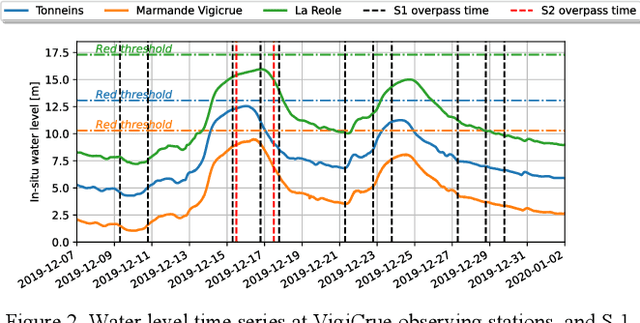
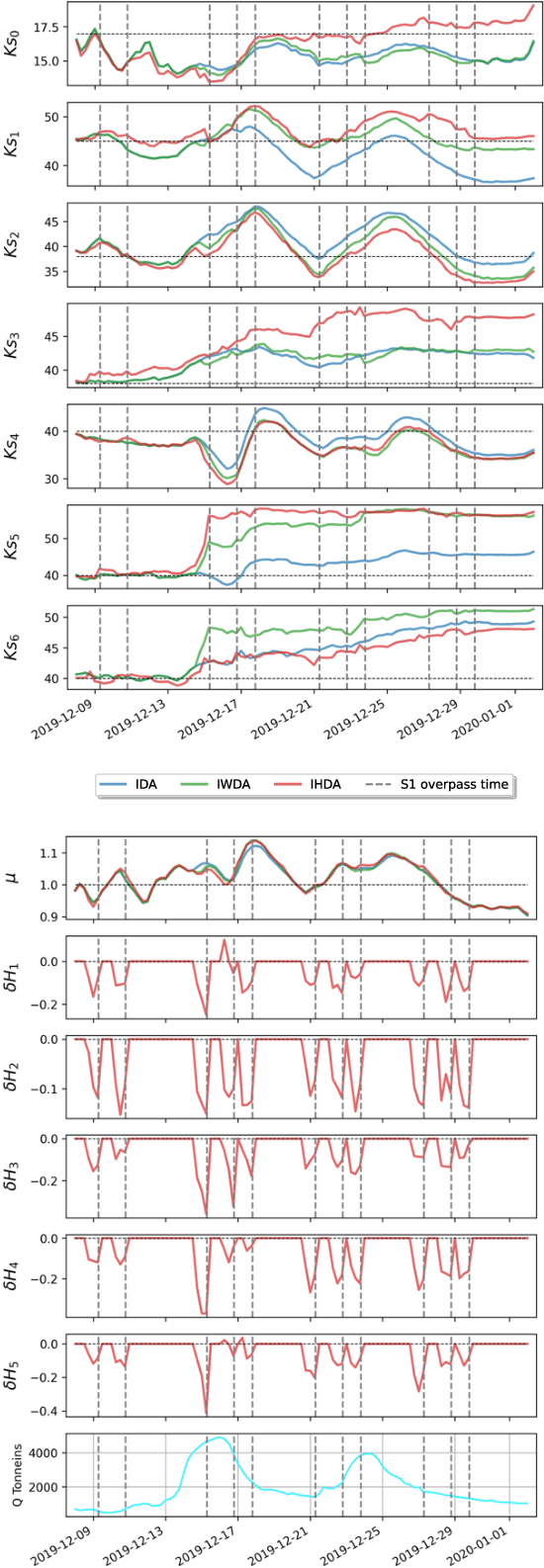
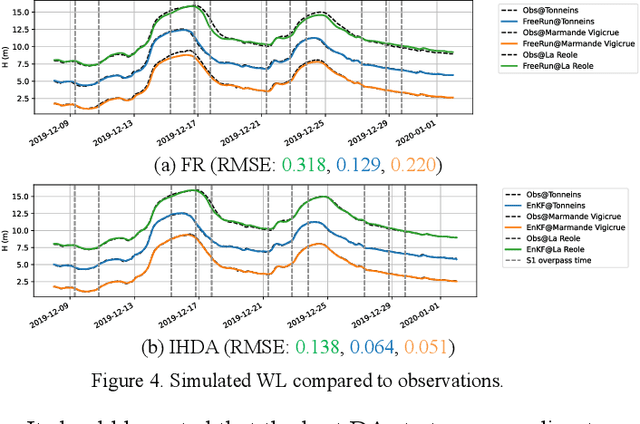
Abstract:Ensemble data assimilation in flood forecasting depends strongly on the density, frequency and statistics of errors associated with the observation network. This work focuses on the assimilation of 2D flood extent data, expressed in terms of wet surface ratio, in addition to the in-situ water level data. The objective is to improve the representation of the flood plain dynamics with a TELEMAC-2D model and an Ensemble Kalman Filter (EnKF). The EnKF control vector is composed of friction coefficients and corrective parameters to the input forcing. It is augmented with the water level state averaged over selected subdomains of the floodplain. This work focuses on the 2019 flood event that occurred over the Garonne Marmandaise catchment. The merits of assimilating SAR-derived flood plain data complementary to in-situ water level observations are shown in the control parameter and observation spaces with 1D and 2D assessment metrics. It was also shown that the assimilation of Wet surface Ratio in the flood plain complementary to in-situ data in the river bed brings significative improvement when a corrective term on flood plain hydraulic state is included in the control vector. Yet, it has barely no impact in the river bed that is sufficiently well described by in-situ data. We highlighted that the correction of the hydraulic state in the flood plain significantly improved the flood dynamics, especially during the recession. This proof-of-concept study paves the way towards near-real-time flood forecast, making the most of remote sensing-derived flood observations.
Assimilation of SAR-derived Flood Observations for Improving Fluvial Flood Forecast
May 17, 2022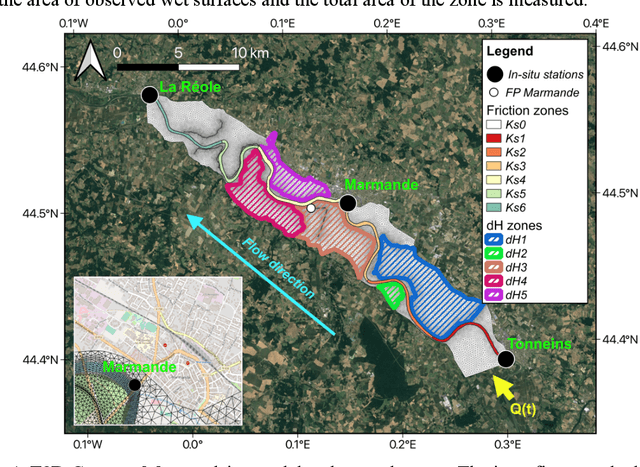

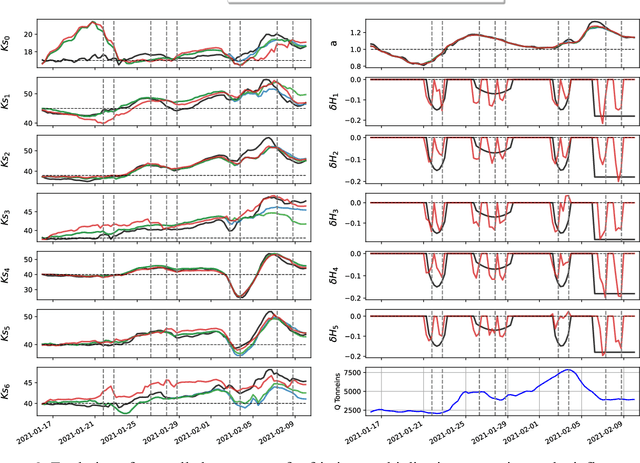

Abstract:As the severity and occurrence of flood events tend to intensify with climate change, the need for flood forecasting capability increases. In this regard, the Flood Detection, Alert and rapid Mapping (FloodDAM) project, funded by Space for Climate Observatory initiatives, was set out to develop pre-operational tools dedicated to enabling quick responses in flood-prone areas, and to improve the reactivity of decision support systems. This work focuses on the assimilation of 2D flood extent data (expressed in terms of wet surface ratios) and in-situ water level data to improve the representation of the flood plain dynamics with a Telemac-2D model and an Ensemble Kalman Filter (EnKF). The EnKF control vector was composed friction coefficients and corrective parameter to the input forcing. It is then augmented with the water level state averaged over several floodplain zones. This work was conducted in the context of Observing System Simulation Experiments (OSSE) based on a real flood event occurred in January-February 2021 on the Garonne Marmandaise catchment. This allows to validate the observation operator associated to the wet surface ratio observations as well as the dual state-parameter sequential correction implemented in this work. The merits of assimilating SAR- derived flood plain data complementary to in-situ water level observations are shown in the control parameter and observation spaces with 1D and 2D assessment metrics. It was also shown that the correction of the hydraulic state significantly improved the flood dynamics, especially during the recession. This proof-of-concept study paves the way towards near-real-time flood forecast, making the most of remote sensing-derived flood observations.
 Add to Chrome
Add to Chrome Add to Firefox
Add to Firefox Add to Edge
Add to Edge